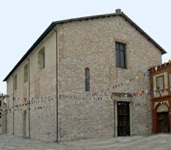
According to Paola Guerrini and Francesca Latini (referenced below, at pp. 304-5, entry 83), the archives of the Abbazia di Sassovivo contain a number of references to this church, the earliest of which dates to 1103 (when it was used to define the boundary of a property in Civitas Fulineata). Bishop Andrea of Foligno (died 1123) granted it to the Abbazia di Sassovivo, following which a monastery was also built here. Pope Clement III confirmed it as a possession of Sassovivo in 1188. Nothing remains of these original structures. However, Paola Guerrini and Francesca Latini (referenced below, at p. 92) noted that it was documented on a number of later occasions, always “in civitas” (inside the first circuit of city walls).
In ca. 1348, Bishop Paolo III Trinci entrusted the church and convent to the Olivetans, who reconstructed the crumbling buildings. It passed to a congregation of Observant Augustinians in 1434. Paola Guerrini and Francesca Latini (referenced below, at pp. 304-5, entry 83) pointed to restorations of the 16th and 18th centuries.

Exterior
The Renaissance portal was built using material saved from a chapel that was destroyed in 1747.
[Side door]
Interior
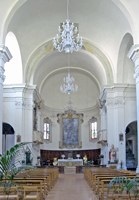
The interior was remodelled in 1747. Evidence of the 14th century building survives in the side doorway of the church, the two mullioned windows and the cross vault of the sacristy.
San Nicolò Polyptych (1492)
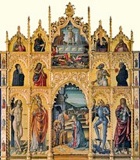
Dominique-Vivant Denon selected the altarpiece for confiscation after the Napoleonic suppression of 1810, and it was duly sent to Paris. Antonio Canova recovered most of the panels in 1817, and they were returned to San Nicolò, where it now forms the altarpiece on the second altar on the right. However, the predella panels, which depict stories of the Passion, were left behind. They are now in the Louvre, Paris and are illustrated in the museum's website.
The polyptych bears the signature “Nicholaus Alunnus Fulginiae” (Nicholas, alumnus of Foligno), which famously led Giorgio Vasari to coin the nickname l’ Alunno. It is now in the Cappella di San Giuseppe at the centre of the right wall.
-
✴The central panel depicts the Nativity, with SS Sebastian and Nicholas of Bari on the left and SS Michael and John the Evangelist on the right.
-
✴The upper register depicts half-length figures of:
-
•SS Monica and John the Baptist on the left; and
-
•the Blessed Peter Crisci and St Nicholas of Tolentino on the right.
-
✴The cusp depicts the Resurrection and the doctors of the church.
Coronation of the Virgin with saints (1495)
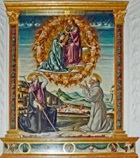
The coronation takes place in a mandorla of angels. Kneeling figures of SS Antony Abbot and Bernardino of Siena witness the scene. St George can be seen killing the dragon in the background.
The predella contains tondi of the Pietà, the Virgin and St John the Evangelist.
Crucifixion (15th century)
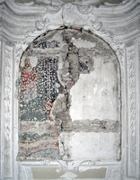
Martyrdom of St Stephen (1613)
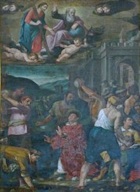
Tondi (17th century)
These six circular panels in the sacristy, which are attributed to Pietro Montanini, depict:
-
✴the Presentation of the Virgin;
-
✴the Nativity (very damaged);
-
✴the Adoration of the Shepherds;
-
✴the Flight to Egypt;
-
✴Jesus with the Doctors in the Temple; and
-
✴ the Risen Christ and St Mary Magdalene (noli me tangere).
Madonna and Child with Saints (1752)
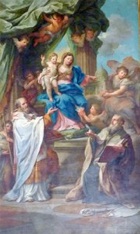
Altarpieces (1760)
Two altarpieces in San Nicolò are signed by Domenico Valeri and dated by inscription;
-
✴Five Augustinian Saints
-
This altarpiece on the left in the 1st bay on the right depicts five Augustinian saints:
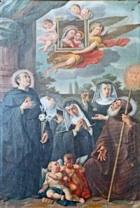
-
•St Nicholas of Tolentino;
-
•St Francis of Paola; and
-
•three beatified Augustinian women, only two of whom can be identified;
-
-Blessed Rita of Cascia; and
-
-Blessed Clare of Montefalco.
-
They gaze in adoration at an image of the Madonna and Child known as the Madonna del Buon Consiglio, which is held by angels.
-
✴Charity of St Thomas of Villanova
-
This altarpiece on the altar of the 3rd bay on the left depicts St Thomas of Villanova preparing to give the Sacraments to a beggar. He is assisted by three other Augustinians, one of whom draws the attention of the beggar to an apparition of the Madonna and Child.
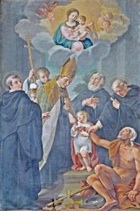
Read more:
P. Guerrini and F. Latini, “Foligno: Dal Municipium Romano alla Civitas Medievale: Archeologia e Storia di una Città Umbra”, (2012) Spoleto
Return to the page on Monuments of Foligno.
Return to to Walk II.



